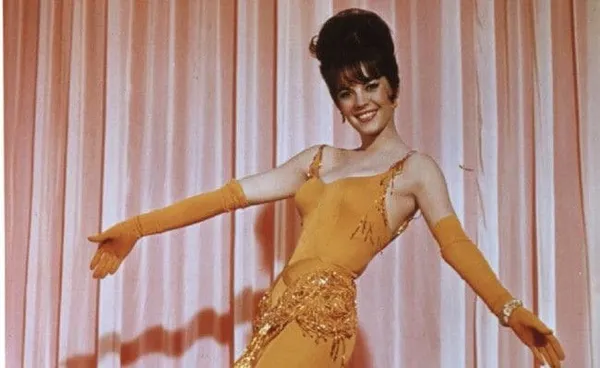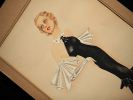Eye For Film >> Movies >> Women He's Undressed (2015) Film Review
Women He's Undressed
Reviewed by: Anne-Katrin Titze

Gillian Armstrong's documentary about the great, triple Best Costume Design Oscar winner, Orry-Kelly, wisely starts off with another great costume designer, Ann Roth, who asks on camera: "You say nobody knows who he is? Who doesn't know who he is?" I agree, if you don't know Orry-Kelly's contributions to cinema and even if you do, Women He's Undressed is a must-see.
The first film image of a star we catch a glimpse of, is Ingrid Bergman, which turns out to be a heads-up when later an excerpt from a letter is read by Darren Gilshenan as Orry-Kelly: "Dear mother, … my war effort is Casablanca."

Catherine Martin, Best Costume Design Oscar winner for Baz Luhrmann's The Great Gatsby and Moulin Rouge with Angus Strathie, talks about the difficulties a gay man in small town Australia must have had in the teens of the last century, explaining his move from seaside Kiama, New South Wales, to Sydney in 1917 where he falls for Gentleman George, a "most notorious pickpocket".
Orry leaves for New York in 1922, becomes friends with Jack Benny, George Burns, Gracie Allen and handsome Archie from Bristol and slowly, after failing as a chorus boy, begins to dress stage actresses such as Ethel Barrymore, Fanny Brice and a newcomer named Katharine Hepburn. He also paints a famous red monkey mural for a bar, a fact that as legend has it, saved his life at some point when the underworld was after him.
At the core of the film stands Orry-Kelly's relationship with Archie Leach, who after having his name changed and becoming a famous movie star, cut all ties with the man he lived with in New York in his early twenties where both tried to make it in showbiz while selling hand-painted ties to support themselves.
In 1931, Orry Kelly arrives in Los Angeles and will soon become known as Orry-Kelly with the hyphen added to make it sound "more French". Film critic/author Leonard Maltin provides some important context, talking about the Great Depression as compared to a booming Hollywood. In place are costume designers Travis Banton at Paramount and Adrian at MGM when Jack Warner hires Orry-Kelly to create the costumes for Kay Francis, Barbara Stanwyck and Ruth Chatterton at Warner Bros. Catherine Martin explains how that came about: "I laugh that Orry-Kelly had this revolutionary idea to include the actresses' faces in the drawings. I relate to that specifically in my work, because Baz always wants the actors' faces in the costumes."
The costumes Orry did for Busby Berkley choreographed musicals - such as 42nd Street and Gold Diggers of 1933 - have the girls dressed as moving ornaments, in the latter within coins and not much else, a very literal take on the song, We're In The Money. He was the man who promoted Dolores Del Rio's naked back, prohibited puffy sleeves in love scenes and enjoyed pushing boundaries with the production code. Bette Davis, called "kind of an odd duck," figure-wise, by Maltin, was one of Orry-Kelly's most frequent stars.
How do you convince an audience that the shocking red dress that Davis wears in Jezebel, filmed in black and white, is actually red? How do you signal illness with little head caps in Dark Victory? Why did director Michael Curtiz need to be tricked into historically accurate costumes for The Private Lives Of Elizabeth And Essex?
Armstrong, using every documentary tool available, presents her fellow Australian via staged stylised re-enactments, mostly of Orry's early years, interviews with contemporary costume designers, actors he dressed, such as Jane Fonda and Angela Lansbury, and a collection of Hollywood historians and friends of friends who knew him. Lansbury, as a "character actor" calls herself the "wrong woman" to talk to about costume, but then explains very well how she and Fonda were juxtaposed In The Cool Of The Day through the use of the outfits they wore designed by Orry.
Kym Barrett, costume designer for The Matrix and The Green Hornet, and Michael Wilkinson, nominated for an Oscar for his costumes in David O Russell's wild 70s extravaganza American Hustle speak about their craft. Wilkinson says: "The most compelling roles are always when you see someone at their most triumphant and glorious moments but also at their deepest darkest moments of despair."
Armstrong shows us both sides of her subject. One of the Glamorous Girls carrying the open coffin with a smiling Orry-Kelly inside at the beginning of the movie is credited as Gracie Otto, the director of The Last Impresario, whose father Barry Otto was featured in Armstrong's terrific Oscar And Lucinda, alongside stars Ralph Fiennes and Cate Blanchett - reminding us that the movie business is a small world with many connections.
Ann Roth was hired by Orry-Kelly to work with him on Oklahoma. She recalls his great sense of humour and how he lovingly made fun of her, the "pretentious brat from a farm in Pennsylvania", wanting to be Coco Chanel with her pearls. Roth - who did most marvellous work from Midnight Cowboy and Klute, to The Hours, The Talented Mr Ripley, winning a Best Costume Design Oscar for The English Patient, to Noah Baumbach's recent While We're Young - explains her method of creation as "purely from instinct" based on great research.
Orry-Kelly, unlike Travis Banton or Adrian, never agreed to a marriage to hide his sexual orientation. He frequented the parties held by Cole Porter and George Cukor. Jane Fonda recalls how Warren Beatty and Natalie Wood were all over each other at Cukor's house and fondly remembers having cold cherry soup, "it was really good".
The green stockings on Shirley MacLaine's legs in Billy Wilder's Irma La Douce bring it back full circle to the red-light district of Woolloomooloo Sydney, frequented by a young Orry. Colleen Atwood, Best Costume Design Oscar winner for Rob Marshall's Chicago and Memoirs Of A Geisha, plus Tim Burton's Alice In Wonderland, says that Irma and her colours stuck with her throughout the years. Looking at her work with Burton, you can tell. Atwood received her first Oscar nomination designing costumes for Armstrong's Little Women, that starred Winona Ryder, Claire Danes and a very young Kirsten Dunst.
Two collaborations with Gene Kelly won Orry-Kelly his first two Oscars, Les Girls and An American In Paris, shared with Walter Plunkett and Irene Sharaff. The third one came for Billy Wilder's Some Like It Hot, in which he draped Marilyn Monroe in, to this day, unbelievably daring dresses. "All his genius was on display," Jane Fonda says. Tony Curtis and Jack Lemon lobbied for Orry-Kelly to make their costumes as well. The result is almost perfect, because as we know, "Nobody's perfect."
Ann Roth in Women He's Undressed, sums up brilliantly what the best costume design is all about: "You keep looking in the mirror and suddenly another being is there and the actor for a second does not recognise themselves. It sounds like magic, but it isn't, it's real. You can do it with a shoulder pad, you can do it with a beer belly - something that removes the actor from himself."
Reviewed on: 25 Oct 2015
















